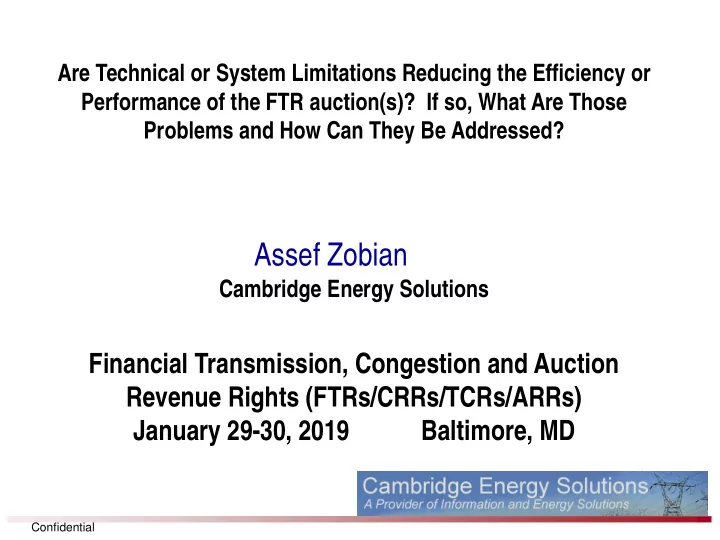

Are Technical or System Limitations Reducing the Efficiency or Performance of the FTR auction(s)? If so, What Are Those Problems and How Can They Be Addressed? Assef Zobian Cambridge Energy Solutions Financial Transmission, Congestion and Auction Revenue Rights (FTRs/CRRs/TCRs/ARRs) January 29-30, 2019 Baltimore, MD Confidential
About CES Cambridge Energy Solutions is a software company with a mission to develop software tools for participants in deregulated electric power markets. CES-US provides information and tools to assist market participants in analyzing the electricity markets on a locational basis, forecast and value transmission congestion, and to understand the fundamental drivers of short- and long-term prices. CES-US staff are experts on market structures in the US, system operation and related information technology Confidential
Presentation Outline The FTR Auctions and Markets Are FTRs necessary? The Auction process and limitations Proposed improvements in the auction model Alternatives to obligation type Point-to-Point rights The Day-Ahead model New hedging products to meet new generation needs Confidential
Objectives of FTRs in Nodal Energy Markets A mechanism for market participants to hedge against the volatility of transmission congestion Generators can sell to a load delivery point Demand/Load can buy from specific generator Traders can provide full service deals Allocate the scarce transmission capacity to market participants in an efficient manner based on value Allocation of the ISO overcollection from the Energy Market Provide price signals for investment in transmission expansion or locational generation Confidential
Are FTRs and FTR Markets Necessary? No, if: Transmission congestion is hidden and cost is socialized, and single market energy price is adopted, or The transmission system is overbuilt to eliminate congestion, and transmission capacity is assumed abundant and not scarce thus has no real value (and investment cost is socialized) Confidential
FTR Markets Administrated and Auctioned by the ISOs Large number of products (square of tradable nodes) Low liquidity/few participants Correlated products (FTRs are Infrequent auctions Complex models combined with low transparency Sensitive to administrator mistakes/assumptions and rules Weak Secondary markets Confidential
The FTR Auction Process Objective to maximize Revenues from selling the expected available transmission capacity (ATC), and minimizing the cost of offered capacity in that auction for a given period (e.g. a month or a year). The difficulty is that the available transmission capacity varies depending on transmission outages and derates, generation and load patterns (Voltage limits) and loopflows, thermal ratings, etc… All ISOs use a single representation of the transmission system and corresponding ATC to approximate the expected most limiting ATCs in that auction period (awarded FTRs must meet Simultaneous Feasibility Test ) Confidential
The “Approximate” Model Transmission outages scheduled for any time in that period that meets certain criteria are assumed on outage in the FTR auction combined together in a single snapshot of the transmission system (ERCOT uses “most severe” day). Static assumptions on loopflows and ratings The most conservative derated limits on constraints are assumed (could be used to reduce revenue inadequacy during the year) Full set of pre and post-contingency constraints are (should be) included Confidential
A Proposal to improve Auction models Clear the auction using multiple representations of the transmission model (e.g., clear the annual auction using different monthly models of the transmission system with expected topology and conditions for each month, AND most-severe day in each month. Single set of awarded annual FTRs or one set for each month). This increases the size of the optimization problem but with improved software algorithms can keep the size of the problem manageable and the solution time acceptable. More frequent auctions: e.g., balance of the year for each month or balance of Month for each day, weekly or daily auctions (improves price discovery and liquidity, and risk profiles) More periods than on and off peak… Confidential
Reduce the number of tradable products? The large number of products (FTR Paths) in the auction can be reduced by replacing the point-to-point rights by flowgate based rights, or as compromise allow for both product types in the same auction. This reduces the number of true valuable products from tens of millions to few hundreds. The point-to-point rights can be easily constructed from flowgate based rights, without any loss of value or impact on hedging strategies, however rights on multiple flowgates will be needed (proportional to the shift factors on each flowgate) Easier to define available capacity on each flowgate These rights are directional and option by definition (not obligation) This should improve the competition for these rights Confidential
Reduce the inherent risk in these products? Increase the attractiveness of the Option type FTRs (and offer in markets where not available) Can we move to Option-only FTR world? ARRs allocated as options Revenue Adequacy- A theoretical limitation? The theory assumes a static grid, and requires obligation type rights Guarantee full funding (e.g. TCCs) Confidential
Enhance the Secondary Markets Understand the impediments to the development of an efficient secondary market Can we reach trading volumes multiple of physical volumes? FTR auctions are limited to physical ATC as defined by the SFT. Confidential
The Day-Ahead Model The FTRs settle based on the congestion components of the DA LMPs. It is important that the models used in the FTR auction and DA market are consistent in terms of topology and limits to prevent model arbitrage. Also, it is important that other assumptions used in the auction are kept in the DA market as much as possible (or should the DA model be closer to the RT model and conditions?) Confidential
New Products for Renewable Resources Renewable energy resources need to finance and build using some level of price/revenue certainty, by selling at a liquid trading hub, and need mechanism to hedge the basis to from their location to the hub. It is difficult to use the fixed MW FTRs to provide a good basis hedge. New products are needed in the market… For example, a solar generation-shaped FTR would be more valuable and useful for a solar power farm. Confidential
Questions? Confidential
Recommend
More recommend